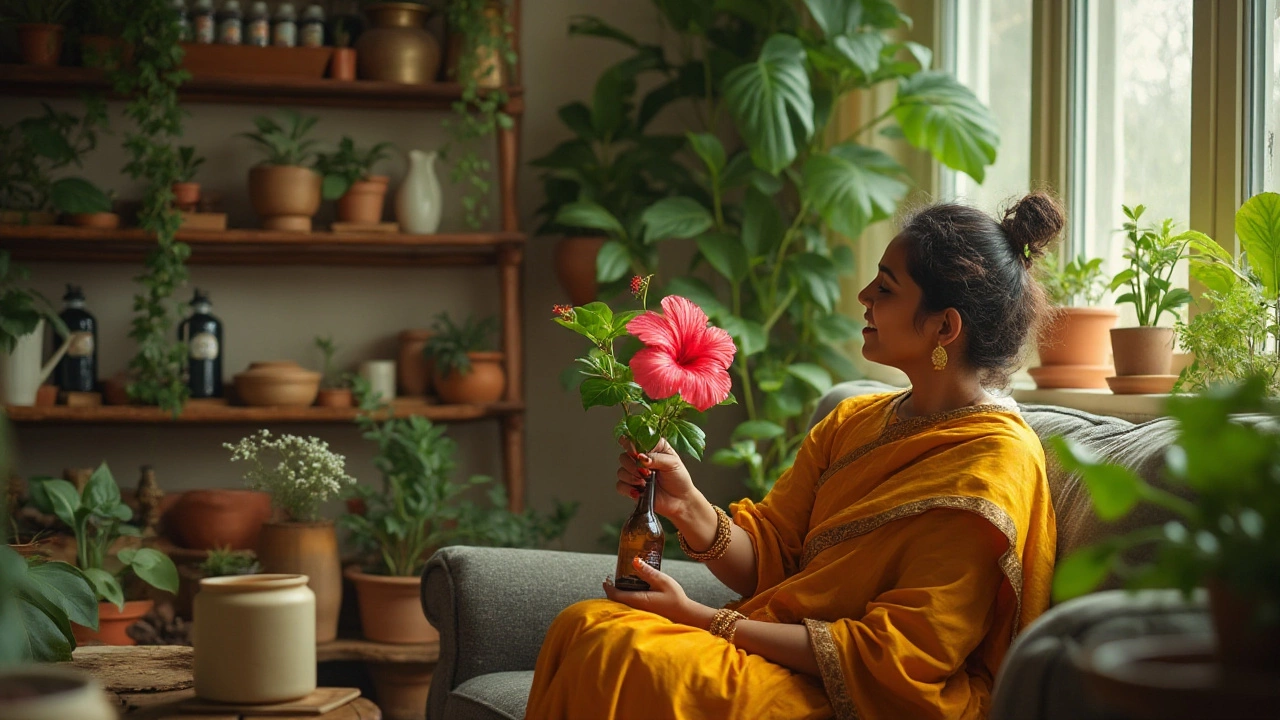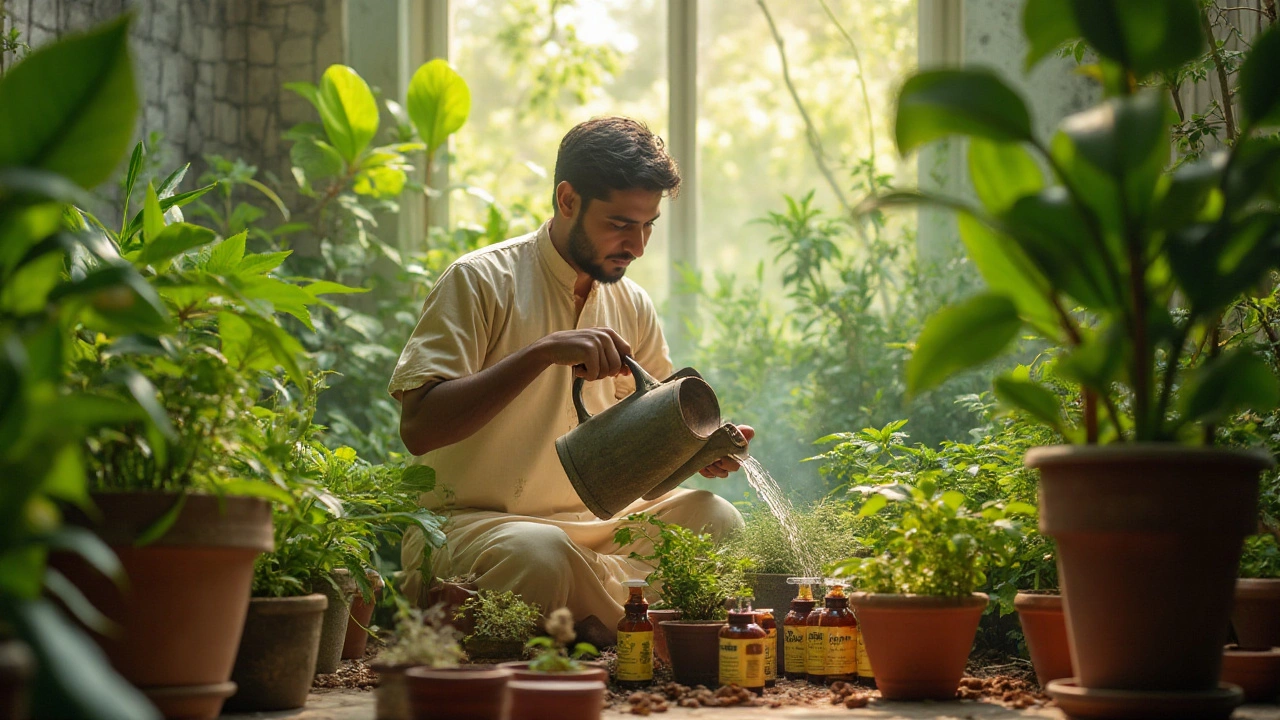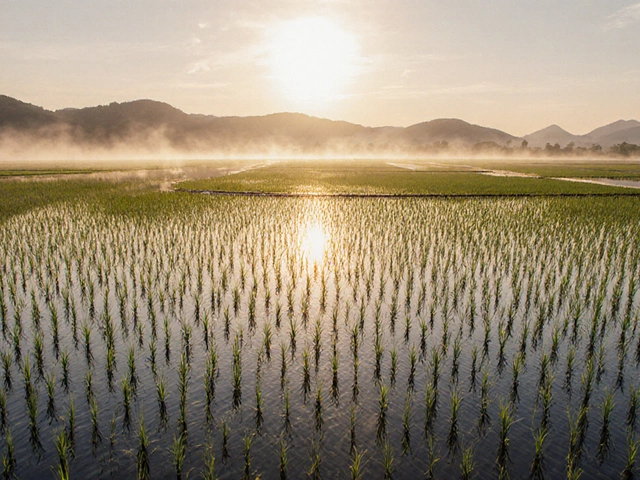Indoor plants bring life and brightness into our homes, and ensuring they thrive involves more than just placing them in a sunny spot. An important part of their growth is the type of liquid nourishment they receive. While water is the most common go-to, several other liquids can supercharge plant growth, improve health, and increase resistance to disease.
Whether you're a veteran plant lover or just getting started, exploring what these liquids offer can open up new possibilities for cultivating a flourishing indoor garden. In this article, we delve into the various liquids that can boost your plants' growth, along with some innovative homebrews and common traps to avoid.
- Understanding Plant Hydration Needs
- Water: The Essential Elixir
- Nutrient-Rich Alternatives
- Innovative DIY Plant Solutions
- Common Mistakes and Best Practices
Understanding Plant Hydration Needs
The unassuming act of watering is one of the most essential aspects of indoor plants care yet often overlooked in its complexity. Each species boasts unique hydration requirements, making it critical to understand these needs to maintain their vibrancy and health. The primary factor in determining water need is the climate zone, as both humidity and temperature play pivotal roles in how much water a plant requires. For instance, tropical plants generally demand more frequent watering to mimic the damp conditions of their native habitats. Conversely, succulents, hailing from arid regions, thrive on sparse watering schedules and can suffer from overwatering, leading to root rot.
Water absorption strategies are biological marvels that cater to particular plant needs. Plants actively manage how much water they absorb through their root systems, with some sophisticated mechanisms developed over millennia. Through a process known as capillary action, water travels up through the roots and into the plant's tissues. This intricate process is influenced by various factors such as root health, soil type, and even the time of day at which watering occurs. Many plant enthusiasts find success through trial and error, observing changes in leaf texture or color as a barometer for hydration levels. According to
Gardener's World Magazine, "Tailoring your watering schedule to your plants' natural rhythms is akin to aligning to a partner's heartbeat—it needs to be in sync."
When we talk about hydration, one must also acknowledge the quality of the water itself. Tap water might be the default choice, but its chemical composition can sometimes be less than ideal for certain plant species. Chlorine, often found in municipal water supplies, can accumulate in soil over time, stunting growth or causing leaf burn. Aeration of tap water by letting it stand for a day before use can mitigate some of these negatives. Alternatively, rainwater or distilled water can be used to ensure a more neutral water source. A small investment in a rainwater collection system could provide a renewable, eco-friendly solution for avid gardeners. The subtle art of water management includes both its amount and quality—an essential tip for plant care.
Humidity, a sometimes overlooked aspect of indoor plant care, plays a significant role in a plant's ability to utilize water. Plants in high-humidity environments may absorb water more directly through leaf pores via a process known as foliar absorption. This is particularly vital for tropical varieties and ferns, which can become quickly desiccated in the dry air typical of modern heating systems. To mimic their lush environments, a combination of frequent misting and strategically placed humidifiers can create a microenvironment that mirrors their natural habitat conditions. Balancing light and water needs while considering humidity levels creates a well-rounded approach for optimal plant health.
One shouldn't underestimate the soil's role in a plant's hydration strategy. Different plants might require distinct soil types that range from sandy to dense clay compositions, each with its unique water retention characteristics. The importance of drainage cannot be overstated; waterlogged soil often leads to oxygen depletion around roots. A good rule of thumb is to select soil mixes that match the natural ground from which the plant originates. For many houseplants, a mixture with equal parts of potting soil, peat moss, and perlite offers excellent drainage while retaining the necessary moisture around roots. This provides a conducive environment for robust root health without water-logging, a fine line any plant aficionado must walk, especially indoors.
Water: The Essential Elixir
Water is undeniably the cornerstone of any thriving indoor plant setup. It serves as the primary vehicle that enables plants to absorb essential nutrients from the soil. In the world of gardening and indoor plants, knowing when and how much to water can make the difference between lush, vibrant leaves and wilting, sad-looking stems. Plants require water not only for photosynthesis—the process by which they convert sunlight into energy—but also to transport these nutrients to various parts of the plant. This dynamic, though seemingly straightforward, is influenced heavily by factors such as plant type, climate, and even the composition of the soil being used.
It's interesting to note that many indoor plant growth issues stem from improper watering techniques. Overwatering is a common mistake, leading often to waterlogged roots and the notorious root rot, which many houseplants are unable to recover from. Conversely, underwatering can make plants weak and more susceptible to pests. Striking a balance involves paying attention to the plant's potting medium and noticing when the topsoil has dried out to about an inch deep. Typically, succulents and cacti require less frequent watering when compared to more tropical varieties like ferns or peace lilies.
To enhance understanding, a look at plant biology reveals how pivotal water is for maintaining cell turgidity—keeping those leaves perky and upright. During times of water scarcity, plants close their stomata, tiny pores found on leaves, to conserve moisture. This process, while essential for survival, slows down photosynthesis and impacts growth. Therefore, mindful watering can optimize these natural processes to maintain healthy growth. A suitable watering schedule adjusted to seasonal changes—more water during active growth seasons like spring and less during dormancy in winter—is crucial.
"Water is life's matter and matrix, mother and medium. There is no life without water," Albert Szent-Gyorgyi, a Hungarian biochemist, succinctly encapsulated the essence of this life-giving liquid.
For those who enjoy diving into the science, understanding the water's quality is equally important. Hard water, for instance, contains high levels of calcium and magnesium, which can lead to unsightly deposits on leaves and soil over time. This can hinder the plant's ability to absorb nutrients effectively. Plants, particularly those endemic to rainforests, may appreciate water that closely mimics natural rain, such as collected rainwater or filtered rainwater. Additionally, using room temperature water helps prevent shock, especially important for sensitive indoor species. Investing a little time to know your water—testing pH levels and treating the fluid if necessary—can turn your watering routine into a gentle, beneficial ritual for your gardening endeavors.

Nutrient-Rich Alternatives
When it comes to nurturing your indoor plants to their fullest potential, it’s essential to explore beyond the typical watering can filled with H2O. While water provides the necessary hydration, it's often the extra nutrients that make a noticeable difference in plant vitality and robustness. Houseplants, which hail from diverse natural habitats, may require more than just standard care to replicate the balanced nutrition they thrive on in the wild. For instance, rainwater—notably purer and richer in minute nutrients such as nitrates—is often the gold standard; it's what many plants receive in their natural environments. But there are other nutrient-rich options that you can easily incorporate into your plant care routine.
Compost tea is one of these stellar alternatives. It’s a liquid derived from steeping compost in water, much like you brew tea with leaves. This traditional method has been used by gardeners for decades, maybe even centuries, as a way to increase microbial activity and provide a wealth of soluble nutrients. By delivering this liquid to your indoor plants, you're not only feeding them with immediately available nutrients but also enhancing the soil biome, crucial for sustained plant health.
A recent study from the University of Vermont indicates that plants treated with compost tea displayed significantly better growth rates and flowering compared to those irrigated with water alone.
Additionally, liquid seaweed fertilizers present another nutrient-rich option to consider. Extracted from marine sea plants, these fertilizers are a nutrient haven, loaded with potassium, zinc, and microbes that strengthen plant immunity. The presence of natural growth hormones known as cytokinins promotes cell division, enhancing root growth and boosting overall plant vitality. This makes them particularly effective for ornamental plants craving an extra boost in vibrant foliage and enhanced blooming cycles.
Not to be overlooked are the benefits of homemade banana peel water, which comes packed with potassium. This mineral is vital for proper plant function, assisting processes such as water regulation within the plant’s cells and strengthening its immune system to fend off diseases. To prepare this potent brew, simply soak banana peels in water for several days before applying it directly to the plant’s roots.
| Liquid | Main Benefit |
|---|---|
| Compost Tea | Boosts microbial activity |
| Liquid Seaweed | Enhances plant immunity |
| Banana Peel Water | Increases potassium levels |
These options not only nourish your indoor plants in meaningful ways, but they also promote sustainable gardening practices by making use of renewable resources. Integrating nutrient-rich alternatives can transform your green spaces into lush, thriving ecosystems that not only look beautiful but thrive with health and vitality.
Innovative DIY Plant Solutions
Exploring the world of DIY liquids for indoor plants offers a fascinating journey into the very science of plant care. While water remains the foundation for any indoor gardening endeavor, certain do-it-yourself concoctions can significantly elevate your plant's health. One intriguing option is the use of plant growth liquids crafted from materials you might already have in your kitchen. For example, banana peel tea is renowned for its potassium-rich nature, offering a gentle nutrient boost when steeped in water and used sparingly at the base of indoor plants.
Another remarkable DIY solution involves Epsom salt. Dissolving a tablespoon in a gallon of water creates a magnesium-rich mix cherished by plants like tomatoes and roses. This solution can help improve chlorophyll production, thus enhancing photosynthesis. Coffee grounds, too, can be converted into a gentle acidifying solution for acid-loving plants such as ferns and azaleas. When used correctly, these simple creations not only feed the plants but also build up the soil's richness over time.
For those who enjoy crafting homemade fertilizers, aquarium water (from freshwater tanks) is a hidden gem. Infused naturally with nutrients from fish waste, this water acts like a mild organic fertilizer. Be sure to use it only for non-edible plants unless you’re confident the tank has been kept free of harmful chemicals. Additionally, consider the ancient practice of compost tea, a living fertilizer teeming with beneficial microorganisms. While it requires a bit of patience to brew, the results can energize your plant’s growth in a way that traditional fertilizers cannot match.
"Gardening is the art that uses flowers and plants as paint, and the soil and sky as canvas." — Elizabeth Murray
As we look at more inventive methods, consider using gel crystals, commonly found in DIY stores, to maintain moisture levels. When soaked in fertilizers, these crystals continuously release nutrients, simplifying plant care routines. Such innovations exemplify how a combination of creativity and science can result in lasting, sustainable solutions for indoor gardening enthusiasts.
Lastly, embracing the use of DIY oat water is yet another game-changer. When oats are soaked and strained, the water left behind offers a combination of sugars and starches that can invigorate root systems. Though unconventional, these methods increasingly become a favorite as gardeners worldwide seek eco-friendly, effective options that reflect nature’s own ingenuity right inside their homes. So whether you’re experimenting with banana peel tea or testing out compost brewing, these DIY solutions transform indoor gardening into a rewarding pursuit of growth and discovery, perfectly accessible with just a touch of curiosity and a splash of innovation.

Common Mistakes and Best Practices
When it comes to nurturing indoor plants, the journey is often filled with equal parts joy and discovery, yet it can also be riddled with mishaps that put your greenery at risk. A common oversight many plant enthusiasts encounter is overwatering, stemming from the well-intentioned but misguided belief that more moisture equates to healthier growth. This assumption can lead to root rot, a condition that spells trouble for your plant's health as soggy soil depletes essential oxygen needed for root function. To sidestep this pitfall, pay careful attention to your plant's unique watering needs. Understanding and adjusting to seasonal changes—where the coolness of winter may warrant less frequent watering compared to the sun-filled days of summer—can also make a big difference.
On the flip side, neglecting the potential of nutrient-rich alternatives to plain water is a missed opportunity in your plant care routine. Liquids like compost tea, created from steeping compost in water, are brimming with beneficial microbes that offer a nutrient boost. Additionally, some gardeners swear by the secret of using diluted aquariums water, as the waste from fish tanks can be a gentle fertilizer, adding essential nitrogen back into the soil. Crafting a batch of this plant food is simple and does wonders in mimicking natural fertilization cycles. Remember, not all plants are the same, so it's crucial to tailor your liquid choices based on the specific requirements of each species.
Another misstep often encountered is the reliance on a one-size-fits-all approach to gardening tips. For example, while some plants, like succulents and cacti, thrive with sparse watering, others, such as ferns and peace lilies, require consistently moist soil. Incorrectly applying these protocols can lead to your plant's decline. A best practice is to study each plant type, perhaps keeping a journal to track their responses, ensuring you meet their distinct needs. Engaging with online forums or plant clubs can also provide insights and updates on current growing techniques.
“Plants, like humans, have varying needs and personalities. Finding their balance not only helps them thrive but enriches our connection to nature.” — Sandra Keller, Botanical Expert
Finally, one cannot overlook the importance of the water quality used in tending to your indoor plants. Unfiltered tap water often contains minerals and chemicals like chlorine and fluoride, which may adversely affect plant health over time. The use of filtered or distilled water helps prevent these potential issues, ensuring that plant nutrients are not disrupted. Some plants, such as orchids and bromeliads, are particularly sensitive to water impurities, making it vital to consider the source of hydration for your green friends.
| Common Mistake | Solution |
|---|---|
| Overwatering | Check soil moisture levels regularly, use pots with drainage holes. |
| Wrong Liquid Choice | Research plant-specific liquid requirements, incorporate compost tea. |
| Unfiltered Water Usage | Opt for distilled or rainwater, especially for sensitive plants. |





